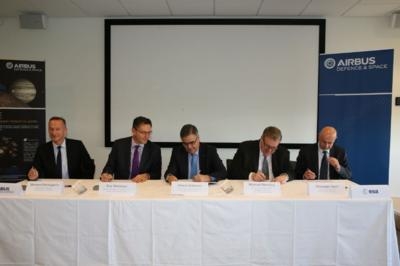Signs $386 Million Contract For ESA’s Next Life-Tracker Inside The Solar System
The European Space Agency (ESA) and Airbus Defense and Space, the world’s second largest space company, have signed a €350M (approx $386 million) contract to develop and build ESA’s JUICE (JUpiter ICy moons Explorer) spacecraft. The contract was signed in Toulouse in the presence of Alvaro Gimenez, Director of Science and Robotic Exploration at ESA, and Eric Béranger, Head of Space Systems Programs at Airbus Defense and Space. JUICE is the first large mission of the ESA Cosmic Vision program, with a launch date in 2022.

“Building-on the expertise we developed on our sites in Toulouse (France), Friedrichshafen (Germany), Stevenage (UK) and Madrid (Spain), the Airbus Defense and Space project team is now running at full speed and the first equipment is expected for delivery in summer 2016,” stated François Auque, Head of Space Systems. “The selection of subcontractors has started and will be completed by 2017, and we will be prime contractor for an industrial consortium of more than 60 European companies. When the project reaches its peak activity around 2017-2018, up to 150 people will be working in the prime project team,” Auque added.
JUICE is the first European mission to Jupiter; its overarching theme is the emergence of habitable worlds around gas giants. JUICE will investigate the Jovian system, with a focus on its icy moons and the possibly ocean-bearing worlds of Europa, Ganymede and Callisto. The mission will study the Jovian system addressing two key themes: exploration of the habitable zone within the Galilean satellites, and exploration of the Jupiter system as the archetype of gas giants.
Following a launch on Ariane 5, JUICE will cruise for 7.5 years making extensive use of gravity assist manoeuvres (in order to save fuel and energy) around the Earth, Venus and Mars before reaching the Jovian system. After insertion into Jupiter’s orbit, JUICE will use multiple fly-bys to complete a comprehensive orbital tour over 3.5 years. At the end of the tour, JUICE will be set in orbit around Ganymede, becoming the first spacecraft ever to enter orbit around an icy moon in the outer Solar System. The complex mission profile will be supported by dedicated navigation cameras on-board the spacecraft.
To fulfil its scientific mission, the spacecraft will carry 10 instruments covering a wide range of measurement techniques (optical, sub-millimetre, radar, laser altimeter, magnetic, electric, plasma and particle sensors, and radio-science). To avoid any perturbation of the scientific instruments, the spacecraft will have an unprecedented level of magnetic cleanliness.
Weighing five and a half metric tons, JUICE will be powered by a the largest solar generator ever built for an interplanetary mission. This will ensure the spacecraft produces enough energy even in the low solar environment at Jupiter.
Airbus Defense and Space has unparalleled experience in designing and building scientific exploration spacecraft, having been involved in every European interplanetary mission. Its heritage includes missions to Venus (Venus Express), Mars (Mars Express),Titan (Huygens), and comet 67P / Chuyrumov-Gerasimenko (Rosetta). The company is currently building missions to the Sun (Solar Orbiter), Mercury (BepiColombo) and Mars (ExoMars), as well as all the satellites built and under construction for Earth research (Swarm, Cryosat, the Sentinel satellites and many more…).
These previous missions have allowed Airbus Defense and Space to develop unique expertise in autonomy, allowing spacecraft to be self-sufficient during long-duration cruise phases as seen on Rosetta, as well as careful electromagnetic cleanliness plans, which are essential in missions like Swarm - the magnetic field measurement mission.
(Image provided with Airbus Defense and Space news release)
 ANN's Daily Aero-Term (04.25.24): Airport Rotating Beacon
ANN's Daily Aero-Term (04.25.24): Airport Rotating Beacon ANN's Daily Aero-Linx (04.25.24)
ANN's Daily Aero-Linx (04.25.24) Klyde Morris (04.22.24)
Klyde Morris (04.22.24) Airborne 04.24.24: INTEGRAL E, Elixir USA, M700 RVSM
Airborne 04.24.24: INTEGRAL E, Elixir USA, M700 RVSM Airborne 04.22.24: Rotor X Worsens, Airport Fees 4 FNB?, USMC Drone Pilot
Airborne 04.22.24: Rotor X Worsens, Airport Fees 4 FNB?, USMC Drone Pilot



